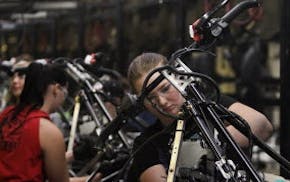Paul S. Kramer was born in rural North Dakota, but decided early that farming and schooling weren't for him. Instead he turned to art, and it sustained him for decades as a painter, a gallery director, a teacher to scores of aspiring artists, and eventually, as one of the most respected Minnesota artists of the 20th century.
Kramer died Aug. 31 at age 93, leaving hundreds of paintings.
Kramer liked to paint in his studio in St. Paul, where he would immerse himself in his work while listening to classical music, yet he always made it home for dinner with his family. He painted still lifes as well as street scenes in St. Paul and depictions of life in small towns along the Mississippi River. He also drew on his experiences from Europe, where he traveled twice for yearlong sojourns that fueled his imagination and provided adventures for his wife and children.
For years, Kramer directed the fine arts department at the Minnesota State Fair and was a teacher and exhibitions director at St. Paul Gallery and School of Art, which later became the Minnesota Museum of American Art.
He was known for his gentle, quiet manner, his sense of humor and his curiosity, as well as a deep commitment to the craft of painting. After his death, his family received letters from a number of former students who described him as a mentor who changed their lives.
"Just about every facet of art activity in the Twin Cities he was engaged in," said Julie L'Enfant, an art history scholar at the College of Visual Arts in St. Paul and author of a book about Kramer, due out in January. "He was a realist painter, although his work has dreamlike qualities and very personal qualities that make it his own. ... He told me he would see something real, but when he started to paint, other images would come in, making it sort of dreamlike."
Kramer was born in 1919 in Sheyenne, N.D., the eighth of 10 children. His father was a farmer raised in the Mennonite tradition, and Paul moved with his family to Minnesota when he was a young boy. He worked on the family's farm in South St. Paul, where they grew vegetables, and he later helped on a dairy farm near Hugo.
A map of the United States that hung in an elementary school classroom inspired him to draw, and he became consumed with mastering the form.
"He said it was something he thought he could actually do," said his daughter, Joan Kramer-Tanck.
"He said school wasn't for [him], but he was willing to work hard. So he worked at that. Sometimes he would stay up all night, just sketching and sketching. From early on, he wanted to draw."
During the Depression, Kramer, a teenager, went to work for the Civilian Conservation Corps, planting trees in northern Minnesota. But he also became the work camp's self-taught sign painter, according to L'Enfant's forthcoming book: "Other Realities: The Art of Paul S. Kramer."
After Pearl Harbor, he enlisted in the Army Air Corps and landed at Omaha Beach the day after D-Day. His job was to load bombs and maintain guns on fighter planes. In his downtime, he painted nose art on the planes and insignia on officers' jackets, according to the book.
After the war, he took an art class in France and then returned to St. Paul, where he was married in 1946. After taking local art classes, Kramer was encouraged by his wife, Mary, and his teacher, the renowned Minnesota painter Clement Haupers, to use the GI Bill and study at the nationally recognized Pennsylvania Academy of the Fine Arts in Philadelphia.
In 1956, he traveled with his family to Spain, returning to St. Paul a year later. In 1969, the family traveled to Scotland for a year and later toured the continent in a Volkswagen van. He was also an entrepreneur who, with his wife, started an art supply store, frame shop and art gallery in St. Paul in the 1960s.
Kramer is survived by his wife of 65 years; his brother, Alton; his daughter; two sons, Wes and Leon Kramer, who for 40 years have operated Kramer Gallery in the Twin Cities. He also has eight grandchildren and two great-grandchildren. A memorial service has been held.
Brad Schrade • 612-673-4777

Minnesota plan to close state addiction treatment facilities faces pushback

Why you should donate clothing: It (probably) won't end up at the dump
4 are now charged in inside job armed robbery of Hopkins grocery store that netted $45K

